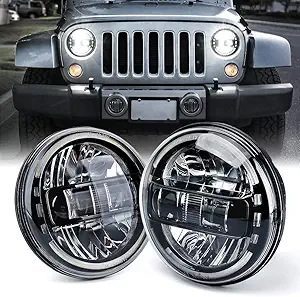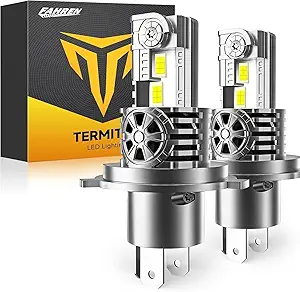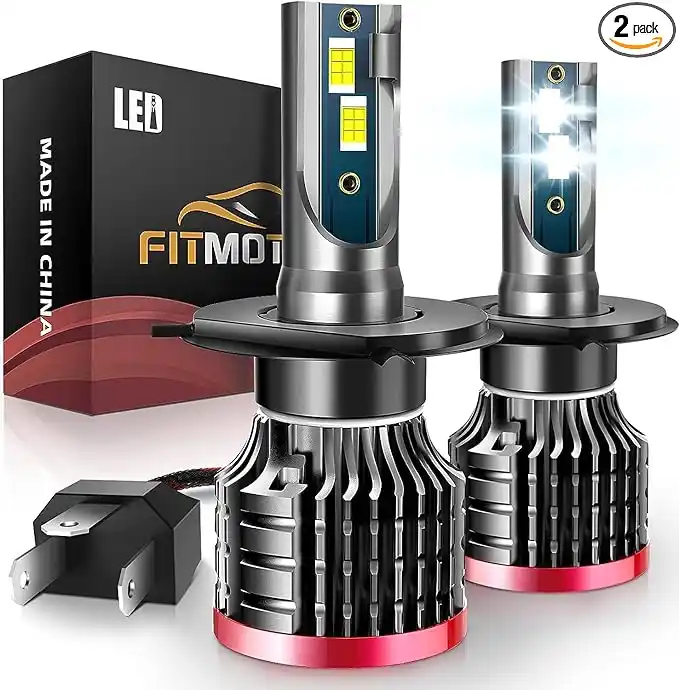Upgrading to LED headlights is one of those rare mods that’s both stupid-easy and instantly rewarding. Whether you’re rolling in a 20-year-old sedan or a weekend cruiser bike, the difference is night and day—literally. No mechanic skills needed.
The 5-Minute Install:
- Yank out your dim old halogens
- Slot in the LEDs (plug-and-play or with an adapter)
- Lock them in straight (alignment matters!)
- Test the beam pattern on your garage wall
- Enjoy roads that actually look illuminated
No flickering, no weird wiring—just crisp white light that makes night driving less exhausting. The best part? You’ll wonder why you didn’t do this years ago.
Let’s get into the nitty-gritty: picking the right bulbs and avoiding common screwups.
Table of Contents
The LED Advantage: Brightness, Safety & Smarts
Old-school halogens are outdated for a reason—they burn out fast, cast that dingy yellow glow, and suck up way more power than they should. LEDs? They’re the upgrade your ride actually deserves. Crisp white light cuts through the dark like a knife, they sip energy instead of guzzling it, and they’ll outlast halogens by decades, not just years.
Swapping them in is a no-brainer, too. Most plug-and-play kits take minutes to install, no wiring headaches required. Whether you’re a mod-happy gearhead or just someone who hates squinting at unlit roads, LEDs are the easiest way to see better, look sharper, and drive safer—all at once.
Why Upgrade to LED Headlights?
LEDs (Light Emitting Diodes) aren’t just fancy bulbs—they’re a full-blown lighting revolution. What started as a premium feature in luxury cars is now a non-negotiable upgrade for anyone who drives at night, whether you’re commuting, off-roading, or hitting the open road on a bike.

The Headlight Timeline:
- Halogens: Budget-friendly but weak—like driving with candlelight
- HIDs: Brighter but sluggish (ever waited for them to “warm up”?)
- LEDs: Instant full brightness, sip power, and outlive your car
Bottom line? If your roads are dark, winding, or foggy, LEDs aren’t just nice to have—they’re a safety essential. Ditch the dim old tech and actually see where you’re going.
Installing LED Headlights in Older Cars: Step-by-Step
Got a 90s or early 2000s car? Good news: Your old clunker can absolutely get LED headlights. Forget what the skeptics say—with a basic plug-and-play conversion kit, you’re about 15 minutes away from light that doesn’t look like it came from a 1970s flashlight.
What You’ll Need:
- LED bulbs (Match your housing—H4, H7, etc. Check your manual or pull the old bulbs to confirm)
- Anti-flicker resistors (Only if your dash throws error lights after install)
- Basic tools (Screwdriver, maybe pliers)
- Gloves (Fingerprints on bulbs = early burnout)


The Dirty Work:
- Get to the housing (Under hood or behind wheel liner—YouTube your specific model if stuck)
- Yank the old halogens (Unplug, remove clip/ring, pull straight out)
- Plug in LEDs (Match the tabs, don’t force it)
- Lock ’em down (Secure any brackets or adapters)
- Aim properly (Critical step—more below)
Pro Move: Before buttoning everything up, park 25 feet from a garage door at night. The cutoff line should sit slightly below headlight height. Too high? You’ll blind traffic. Too low? You’re back to halogen-level visibility. Adjust the screws on the housing until it’s just right.
Why Bother? Because driving with halogens in 2024 is like using a flip phone—technically it works, but you’re making life harder than it needs to be.
Install LED Headlights Near Me: Do You Need a Pro?
Installing LED headlights is simple for most DIYers, but if you want peace of mind, you can search “Install LED headlights near me” and find local mechanics or auto shops that handle LED upgrades.
Prices vary between $50–$150 depending on your vehicle type and local labor rates. Still, if you’re comfortable working under the hood, it’s a 15-minute DIY job.
💡 Pro Insight:
According to PowerBulbs.com, “Over 70% of LED conversions are done at home—thanks to universal kits and plug-and-play designs.”
LED Headlight Installation for Cars & Bikes – The Right Way
Car Installation (10-15 minute job)
- Prep Work
- Open hood fully and locate headlight housing
- Disconnect negative battery terminal (prevents electrical shorts)
- Clean hands or wear gloves (oil damages LEDs)
- Bulb Replacement
- Remove weatherproof cap from headlight back
- Unclip old bulb (don’t twist – most slide out)
- Align new LED’s tabs perfectly before inserting
- Secure with original retaining clip (should click firmly)
- Final Checks
- Reconnect battery
- Test both high and low beams
- Adjust aim using housing screws if needed
🔧 Key Tip: If lights flicker, add load resistors near headlights (not on plastic)
Motorcycle-Specific Guide
- Accessing the Bulb
- Remove entire headlight assembly on sport bikes
- Just pop off cover on cruisers (check service manual)
- Note original bulb orientation before removing
- Critical Installation
- Only use dual-filament LEDs for combo high/low beams
- Ensure LED chips face SIDEWAYS (90° rotation matters)
- Apply dielectric grease to connectors (weatherproofing)
- Vibration Solutions
- Use included rubber anti-vibration pads
- Check tightness every 500 miles initially
- Consider headlight brace for off-road bikes
⚠️ Safety Notice:
- Never touch LED glass directly
- Allow 2″ clearance for heat sinks
- Test beam pattern against garage door at night
Why This Matters:
Proper LED installation gives you 5+ years of ultra-bright light. Done wrong, you’ll be replacing bulbs every 6 months and blinding other riders/drivers. Take the extra 5 minutes to do it right the first time.
How to Install LED Strip Lights in Car Headlights
If you’re going for a custom LED strip (DRL style) inside your headlights, the process is more advanced:
- Open headlight assembly (may require heating in an oven to soften glue)
- Install strip inside housing
- Wire into existing DRL or parking light circuit
- Seal and reassemble headlight
💡 Caution:
Improper sealing can cause condensation or damage. Consider professional help unless you’ve done this before.
Picking the Perfect LED Headlight Kit: What Actually Matters
Don’t waste money on junk LEDs. Here’s what separates the good kits from the roadside trash:

Must-Have Features:
✔ Fanless cooling (No annoying whine, lasts 5x longer than fan models)
✔ Beam adjustability (Look for rotatable bases to fine-tune cutoff)
✔ CANbus compatibility (Unless you enjoy dashboard warning lights)
✔ IP67+ waterproofing (Monsoons and car washes won’t kill them)
✔ Exact bulb match (H4, H7, etc. – wrong type won’t even fit)
Pro Secret:
With dual-beam LEDs (H4/9003), horizontal chip alignment is everything – if the diodes face up/down instead of left/right, you’ll get blinding hotspots and dangerous dark zones. Test against a wall before final install.
Skip These:
✖ “10,000K blue tint” (illegal in most states, actually reduces visibility)
✖ No-name brands with “50,000 hour” claims (they last 6 months)
✖ Kits without anti-vlicker resistors (unless you enjoy electrical gremlins)
Pro Tips for Installing LED Headlights
✅ Wear gloves—Oil from your skin can damage the LED chip over time
✅ Test the lights before sealing—Avoid redoing work
✅ Use dielectric grease to prevent moisture in the socket
✅ Avoid cheap, no-brand bulbs—They often fail or flicker
✅ Check your local laws—Some areas require DOT-approved LEDs
🧰 Expert Advice:
“Most DIY issues come down to orientation and alignment,” says Jason Cunningham, a certified auto lighting technician. “Spend time on beam pattern—it’s more important than just getting the bulb to light up.”
LED Headlight FAQs – Straight Answers
Q: Can I install LED headlights myself?
A: Absolutely. Most LED kits are true plug-and-play—no wiring changes needed. Just swap the bulbs like-for-like.
Q: Can you mess up LED installation?
A: Oh yeah. Get the orientation wrong and you’ll either blind traffic or see worse than with halogens. Alignment matters.
Q: What’s the correct LED positioning?
A: For dual-beam LEDs (like H4), the chips must face 3 and 9 o’clock (horizontal). Up/down mounting screws up the beam pattern.
Q: Horizontal or vertical placement?
A: Always horizontal unless your vehicle’s manual specifies otherwise. This maintains the proper cutoff to avoid dazzling other drivers.
Q: What’s the difference between H4 and H7 bulbs?
A:
- H4 = Dual-beam (one bulb does high and low)
- H7 = Single-beam (separate bulbs for high/low)
Match your existing bulb type—wrong fit means no light.
Pro Tip: Test new LEDs against a garage door at night. Proper beam should have a sharp cutoff line with no dark spots or upward glare.
DIY LED Headlights: See Better, Drive Safer
Upgrading to LEDs isn’t about chasing trends—it’s about finally seeing those unlit backroads and spotting deer before they become hood ornaments. Whether you’re breathing new life into a ’90s beater or tricking out your bike, the difference will shock you.
Why Bother?
- Safety: That crisp white light cuts through rain and fog better than dated halogens
- Longevity: Quality LEDs outlast your car’s alternator
- Easy Win: If you can change a lightbulb at home, you can handle this
Your Turn:
➡️ What ride are you upgrading? Share your LED wins (or horror stories) below
➡️ Need more electrical know-how? Dive into these next:
- Dead Battery? How to Diagnose Alternator Issues Like a Pro
- Fuse Problems? The No-BS Guide to Fixing Blown Fuses

Pingback: Reversing Camera in a Car: Install It. Use It. Love It
Pingback: Car Alarm Keeps Going On and Off? Causes & Expert Fixes
Pingback: Discover the Best Way to Clean a Car (From a 17-Year Pro)
Pingback: How to Drive a Car: A Complete, Helpful Driving Guide (2025)